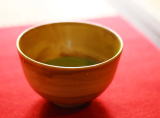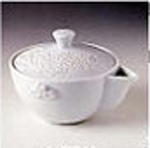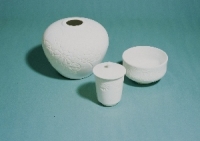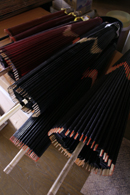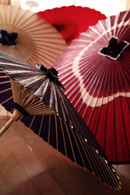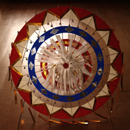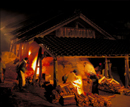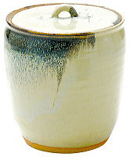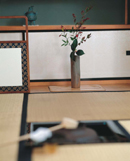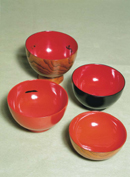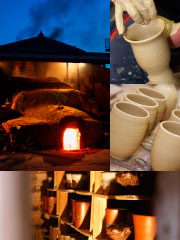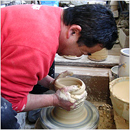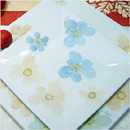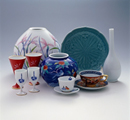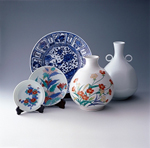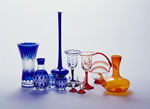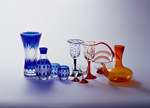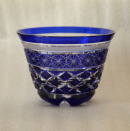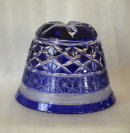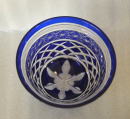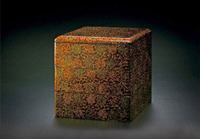
photo by Tohoku Bureau of Economy, Trade and Industry |
TSUGARU NURI |
| (Aomori) / bowl, table, flower vase, tea utensils, nest of boxes |
| TSUGARU NURI was developed by the Tsugaru clan more than 300 years ago
during the Edo Period (1603-1867). TSUGARUNURI is made from Aomori cypress
trees. The material goes through fifty different processes. The end product
is very solid and beautiful. At present, four processes , called "Kara-nuri",
"Nanako-nuri", “Monsha-nuri", and "nishiki-nuri",
are utilized. TSUGARUNURI are designated as a Traditional Craft by the
Japanese Government in 1975. |
| |
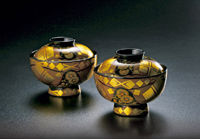
photo by Tohoku Bureau of Economy, Trade and Industry |
HIDEHIRA NURI |
| (Iwate) / bowl, dishes, boxes, tray |
| HIDEHIRA NURI has its origins in Oshu Fujiwara. It was at the height of its prosperity in Hiraizumi. It’s made from dry horse chestnut tree or zelkova wood. After the first primer, a second coat and a top coat , a pattern of a cloud is drawn. Gold leaf is applied just before the dry pattern is set. Its finished with printed figures around the outside of the cloud. |
| |
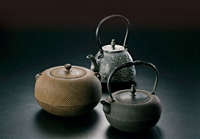
photo by Tohoku Bureau of Economy, Trade and Industry |
NANBU TEKKI |
| (Iwate)/kettle |
| Originating in the mid-17th century in Morioka. This is a hand craft employing
traditional old-fashioned techniques and was designated a Traditional Craft
by the Japanese Government in 1975. |
| |
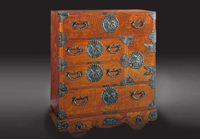
photo by Tohoku Bureau of Economy, Trade and Industry |
IWAYADOU DANSU |
| (Iwate) / chest, cupboard, cabinet, sideboard, TV board, display shelf |
| Characterized by beautiful wooden fittings, carefully lacquered, exciting
and brilliantly hand-carved. It made its debut during latter half of the
18th century by Masahiro Iwaki who lived in the Iwaki village hall castle.
It was designated as a Traditional Craft by the Japanese Government in
1982. |
| |
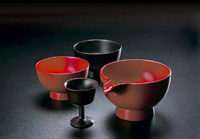
photo by Tohoku Bureau of Economy, Trade and Industry |
JOUHOUJI NURI |
| (Iwate) / bowl, tea utensils, nest of boxes |
| Most of these products have a monochromatic finish with a reduced gloss
color which includes; red and black, with a plain reservoir. It includes
a hand drawn gold leaf diamond shaped designated flower done in lacquer.
It was designated a Traditional Craft by the Japanese Government in 1985. |
| |
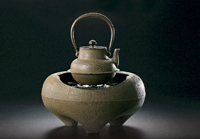
photo by Tohoku Bureau of Economy, Trade and Industry |
YAMAGATA IMONO |
| (Yamagata) / kettle, temple bell, flower vase, steal pot, casting machine |
| Emerging during the Heian Period 950 years ago, the production of this
kettle for tea ceremony has accounted for 80% of the total amount of kettles
in the country. It was designated a Traditional Craft by the Japanese Government
in 1975. |
| |
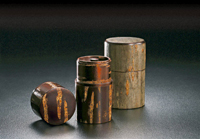
photo by Tohoku Bureau of Economy, Trade and Industry |
KABA ZAIKU |
| (Akita) / tea caddy, candy bowl |
| A rarity in the world known as Sakura leatherwork. This art form shows the combination of beauty and an unusual technique applied to wild cherry tree bark. There are more than ten different types of bark used. It was designated a Traditional Craft by the Japanese Government in 1976. |
| |
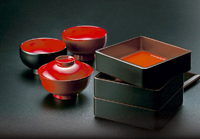
photo by Tohoku Bureau of Economy, Trade and Industry |
KAWATSURA SHIKKI |
| (Akita) / kitchen ware, tea sets, nest boxes, tray |
| The coating process is done in three stages. First, JINURI is where many coats of lacquer are applied. Next, Nakanuri, a second coat is applied. After HANANURI, a finished top coat is achieved without the need of a final polishing. It is low cost and easy to apply. This art form was designated a Traditional Craft by the Japanese Government in 1976. |
| |
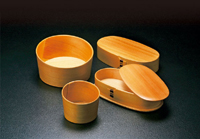
photo by Tohoku Bureau of Economy, Trade and Industry |
OODATE MAGE WAPPA |
| (Akita) / rice bowl, lunch box |
| A thin straight grained strip of natural Akita cedar bark is shaved off
and bent into a circle. This wild cherry tree bark is then sewn together.
It is soft and exhibits a beautiful bright and elegant color. This was
designated a Traditional Craft by the Japanese Government in 1975. |
| |
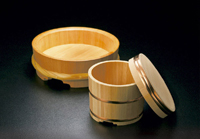
photo by Tohoku Bureau of Economy, Trade and Industry |
AKITA SUGIOKE DARU |
| (Akita) / tab, barrel |
| This craft originated during the late Heian Period. Natural Akita cedar
wood grows beautiful precisely aligned growth rings and it has a wonderful
fragrance.. This art form was designated a Traditional Craft by the Japanese
Government in 1984 |
| |
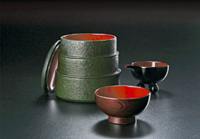
photo by Tohoku Bureau of Economy, Trade and Industry |
NARUKO SHIKKI |
| (Miyagi) / kitchen ware, tea sets, nest boxes, tray |
| It originated more than 350 years ago. Characteristic of Naruko lacquer ware, it incorporates a freshly painted Pheasant motif known as "Hikimono". There is a unique coating technique called "Ryumonnuri (dragon-crest lacquering)". This was designated a Traditional Craft by the Japanese Government in 1991. |
| |
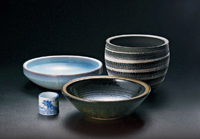
photo by Tohoku Bureau of Economy, Trade and Industry |
AIZU HONGOUYAKI |
| (Fukushima) / tableware, tea sets, vases, lacquer |
| AIZU HONGOUYAKI originated from the idea of castle roof tiles. It has a
history of about 400 years as the oldest earthenware in Northeast Japan.
It is considered a daily product that is easy to work with and was designated
a Traditional Craft by the Japanese Government in 1993. |
| |
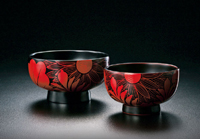
photo by Tohoku Bureau of Economy, Trade and Industry |
AIZU NURI |
| (Fukushima) / bowl, tea utensils, nest of boxes |
| It originated about 500 years ago during the Muromachi Period. Recently,
young craftsman have launched a new brand known as "BITOWA".
And It has spread all over the country. It was designated a Traditional
Craft by the Japanese Government in 1975. |
| |
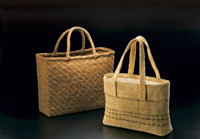
photo by Tohoku Bureau of Economy, Trade and Industry |
OKUAIZU AMIKUMI ZAIKU |
| (Fukushima) / basket, sieve |
| AMIKUMIZAIKU made its debut during the Jomon Period about 2500years ago. It has been made with natural vines and wild grass. Currently there are about only 150 craftsmen practicing this craft. It was designated a Traditional Craft by the Japanese Government in 2003. |
| |
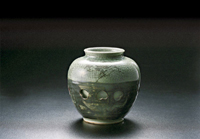
photo by Tohoku Bureau of Economy, Trade and Industry |
OOBORI SOUMAYAKI |
| (Fukushima) / tableware, tea sets |
| OOBORI SOUMAYAKI originated during the early Edo Period (1690). It exhibits
a cracked texture called "blue cracking" and an image of a running
horse. If hot water into it, we can hand easily and hot water hard to cool
down than thin burning product cause thickness burning., It was designated
a Traditional Craft by the Japanese Government in 1978. |
| |
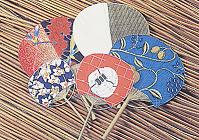
photo by Chiba Prefectural Government |
 BOUSYUU UCHIWA BOUSYUU UCHIWA |
| (Chiba) / handy fan |
| Bousyuu is one of the three major production areas where the Japanese fan
is made. Materials used are paper and cloth. It is said finishing condition
is different from weather. It was designated a Traditional Craft by Japanese
the Government and a Chiba specific craft. |
| |

photo by Kanagawa Prefectural Government |
ODAWARA SHIKKI |
| (Kanagawa) / table ware, tray, nest of boxes |
| Odawara lacquer ware was born during the middle-Muromachi Period. There
was the barrier of Hakone in Odawara town, so the technology of lacquer
ware has been established there. It is characterized by making use of the
natural wood grain and was designated a Traditional Craft by the Japanese
Government in 1984. |
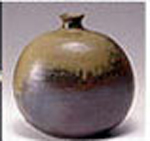
photo by Kansai Bureau of Economy,Trade and Industry HP,Traditional Crafts
information page |
ECHIZEN YAKI |
| (Fukui) / kitchen ware, vase, glass |
| Counted as one of Japan's six oldest kilns, its origin dates back to the
late Heian Period. Loved as daily folksy commodities. It is characterized
by its beautiful and clear gray tone. It was designated a Traditional Craft
by the Japanese Government in 1986. |
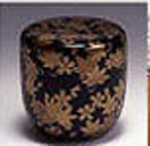
photo by Kansai Bureau of Economy,Trade and Industry HP,Traditional Crafts
information page |
ECHIZEN SHIKKI |
| (Fukui) / table ware, tray, nest of boxes |
| ECHIZEN SHIKKI originated during the 6th century. Its base is black, and
is known for its as wonderful elegant glossy coating. It was designated
a Traditional Craft by the Japanese Government in 1975. |
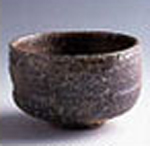
photo by Kansai Bureau of Economy,Trade and Industry HP,Traditional Crafts
information page |
SHIGARAKI YAKI |
| (Shiga) / kitchen ware, vase, figurine |
| Counted as one of Japan's six oldest kilns, Its origin dates back to the
late Tenpyou Period. The raccoon figurine is well known. It was characterized
by HIIRO (fire color) or HAIKABURI (gray tone) or BIDORO. It was designated
a Traditional Craft by the Japanese Goverment in 1975. |
| |
photo by Kansai Bureau of Economy,Trade and Industry HP,Traditional Crafts
information page
photo by Hyougo Prefectural Government, Industrial Labor Department |
IZUSHI YAKI |
| (Hyougo) / tea sets, vase, kitchenware |
| Making its debut during the reign of Emperor of Suinin, silky porcelain
exhibits a clean appearance of dignity and elegance. And shows off more
of a white matrix. It was designated a Traditional Craft by the Japanese
Government in 1980. |
| |
|
photo by Tottori Prefectural Government HP, Tottori Traditional Arts &
Crafts information TORINET-Photos library |
YODOE GASA |
| (Tottori) / umbrella |
| Yodoe umbrellas were produced for four years of Busei during the Edo Period.
Bangasa and Janomegasa are considered mainstream for the Yodoe umbrella.
It is known for practicality and durability and is characterized by its
specific yarn decor and special figures. Now the Yodoe umbrella tradition
continues work to pass on the Yodoe umbrella manufacturing technology.
It has been designated a Tottori specified technical craft. |
| |
photo by Tottori Prefectural Government HP, Tottori Traditional Arts &
Crafts information TORINET
photo by Tottori Prefectural Government HP, Tottori Traditional Arts & Crafts information TORINET-Photos library |
INKYUUZAN YAKI |
| (Tottori) / table ware, vase, tea ceremony goods, kitchenware, decorated
plate |
| It was said the beginning was the mid-Edo Period during the Meiwa years
(1764-1772). Kyoto potters who were invited to Tottori by feudal lord Ikeda
built a kiln. They as a purveyor burned tea set. It has unique characteristics
from using a straw Haikouyaku. It was designated a Tottori specified technology
craft. |
| |
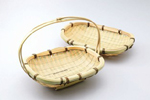
photo by Okayama Prefectural Government HP, Traditional Crafts information
page |
KATSUYAMA TAKEZAIKU |
| (Okayama) / loving ware, basket, vase, kitchenware |
| This is a traditional craft that virtually of handwork passed down in the
land of Katsuyama. Originally products made were used as a tool for living
and farming. So their usefulness has been proven. The sweet smell of bamboo
can make you feel at ease. It was designated a Traditional Craft by Japanese
Government in 1979. |
| |
photo by Okayama Prefectural Government~The country of sunny studio~
photo by Okayama Prefectural Government HP, Traditional Crafts information
page |
BIZEN YAKI |
| (Okayama) / table ware, vase, kitchenware |
| Bizen yaki, one of the six oldest kilns in Japan with a proud tradition
of 1000 years. Products are made without using glaze at all. They are characterized
by rustic and unique products. Made in Bizen city, Okayama city and Setouchi
city in Okayama Prefecture. This craft was designated a Traditional Craft
by the Japanese Government in 1982. |
| |
photo by Okayama Prefectural Government~The country of sunny studio~
photo by Okayama Prefectural Government HP, Traditional Crafts information
page |
GOUBARA SHIKKI |
| (Okayama) / tableware, kitchenware, tray |
| Products are made of rough wood from the chestnut tree grown in the Hiruzen
region. Production was cut off at the end of the war, but in recent years
local volunteers are making an effort to revive it. It has tradition of
600 years. It was designated Okayama specified technology in 1992. |
|
photo by Yamaguchi Prefectural Government HP, Yamaguchi Brand Museum |
HAGI YAKI |
| (Yamaguchi) / tableware, vase, kitchenware, tea sets |
| Made its debut at the end of the 16th century. It was largely characterized
as "NANABAKE of HAGI". It changes colors and luster seven times
with increasing use. It was designated a Traditional Craft by the Japanese
Government in 2002. |
| |
|
photo by Ehime Prefectural Government HP, Ehime good products picture book |
TOBE YAKI |
| (Ehime) / tableware, vase, kitchenware, tea sets |
| Its history is set in 1777 during the Edo Period. The pattern of indigo blue is refreshing when seen on white porcelain. It creates a nostalgic atmosphere with its thick and stout appearance. It was designated a Traditional Craft by the Japanese Government in 1976 and as an intangible cultural assets of Ehime Prefecture in 2005. |
| |
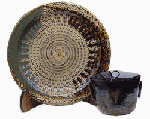
photo by Fukuoka Prefectural Government HP, Traditional Craft page |
KOISHIWARA YAKI |
| (Fukuoka) / tableware, vase, kitchenware, tea sets |
| It has bitterness stout and be famous pottery amongst Kyusyu pottery. It
is said to have made its debut from the 17th century. It is characterized
by its glaze, brush marks, and Tobikanna (special method of producing Japanese
ceramics). Its main production area is the village of HIGSHIMINE. It was
designated a Traditional Craft by the Japanese Government in 1975. |
| |
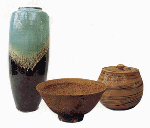
photo by Fukuoka Prefectural Government HP, Traditional Craft page |
AGANO YAKI |
| (Fukuoka) / tea sets, vase, tableware |
| It has been said that it was the beginning in the early 17th century that
Sonkai, a Korean potter, opened his kiln in Fukuchiyama piedmont. Sonkai
was invited by Tadaoki Hosokawa who was feudal lord and master of tea ceremony.
It is a popular good produce for tea ceremony. Its main production area
is the town of Fukuchi. It was designated a Traditional Craft by the Japanese
Government in 1983. |
| |
photo by Institute of Saga Prefectural Tourism Federation |
IMARI・ARITA YAKI |
| (Saga) / tableware, vase, kitchenware, tea sets, decorative plate |
| Made from about 400 years ago, Aritaware was the first porcelain produced
in Japan. It is hard to crack and is a durable white. And It has beautiful
images and color. It is said to have affected the pottery throughout the
world. It was designated a Traditional Craft by the Japanese Government
in 1977. |
| |
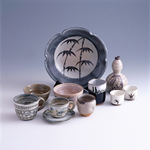
photo by Institute of Saga Prefectural Tourism Federation |
KARATSU YAKI |
| (Saga) / tableware, vase, kitchenware, tea sets, decolating plate |
| It is said the beginning of Karatsu was during the Momoyama Period. Its
characterized by the natural color of the soil without other colors added.
It was designated a Traditional Craft by the Japanese Government in 1988. |
| |
|
photo by Institute of Saga Prefectural Tourism Federation |
HIZEN BIDORO |
| (Saga) / tableware, vase, boxes |
| At the end of the Edo Period, Naomasa Nabeshima, who was the 10th feudal
lord of the Saga clan, made the RIKEN. Flask or beaker for chemistry experiments
was made there. It was the origin of Hizen Bidoro. |
| |
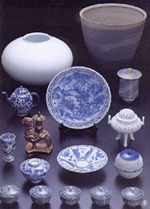
photo by Nagasaki Prefectural Government HP, Nagasaki Traditional Craft
Page and Toukei kids |
HASAMI YAKI |
| (Nagasaki) / tableware, vase, tea sets, incense burner |
| Characterized by its exquisite harmony displayed in white porcelain and
patterns of indigo. It has a history of about 400 years. It has been produced
at affordable prices and considered as useful products for the familiar
life of common people. It was designated a Traditional Craft by the Japanese
Government in 1978. |
| |
|
photo by RMY☆Rimyu |
 EDO KIRIKO EDO KIRIKO |
| (Tokyo) / glass, ornamental plate, tumbler, sake glass |
| It originated in 1834 during the Edo Period. The material used is colored
and transparent glass. Cutting of design is sharp and deep and clear, and
it has a gorgeous finish. It was designated a Tokyo specified technical
craft in 1985, and a Traditional Craft by the Japanese Government in 2002. |
| |

copyright |
KISYUU SHIKKI |
| (Wakayama) / tableware, tray, chest |
| Originating during the Muromachi Period, KISYUU SHIKKI in Wakayama prefecture
is counted amongst Japan's three major production centers. It is craft
encompassing traditional techniques. They include old techniques such as
Kuroe, Negoro, Tenryuu and silk painting. It was designated a Traditional
Craft by the Japanese Government in 1978. |
| |

copyright |
KISO SHIKKI |
| (Nagano) / lunch box, chest, tray, table ware |
| Three traditional skills are designated by as Traditional Crafts by the
Japanese Government known as Kisotsuisyu, Nuriwakeironuri, and Kisosyunkei
in 1975. The medal of the Nagano Winter Olympics in 1998 was made with
Kiso lacquer using this traditional craft. |
| |

copyright |
 NANBU SOUKIRITANSU NANBU SOUKIRITANSU |
| (Aomori) / chest, desk, small chest, boxes |
| Now the only Nanbu Paulownia Chest artist is Ichinohe. All the parts except for the metal fittings are made of wood. Even the Nail fasteners are also made of wood. It brings out the beauty of the material by delicate hand crafting. |
| |

copyright |
NANBU SASAMEKUMI MONYOU KUMIKOZAIKU |
| (Iwate) / screen, paper lantern, folding screen, sliding door, table |
| The new traditional crafts in Iwaate were complete at the end of the Shouwa
Period. A unique pattern that is perceived as three-dimensional and floating,
by combining materials of different colors was achieved. This type craft
is only found in Japan. |
| |

copyright |
HANAMAKI GASA |
| (Iwate) / umbrella |
| This umbrella made its debut in 1801-1803. It’s made with long-jointed
bamboo, and Mino-washi or Karasuyama-washi which are Japanese types of
paper. |
| |

copyright |
MURAKAMI KIBORI TSUISHU |
| (Niigata) / tea ceremony set, saucer, candy bowl, bag |
| The technique was transmitted from the Edo Period (year of Bunsei). It
consists of carving bare wood, and being finally coated using a unique
technique called "SHITOU NURI". It was designated a Traditional
Craft by the Japanese Government in 1976. |
| |

copyright |
TSUBAME TSUIKI DOUKI |
| (Niigata) / teapot, plate, cup |
| Copperware process was transmitted from Sendai city in the middle of the
Edo Period. TSUI means hammer, KI means beating. It is a technology that
produces a three-dimensional product, without any joints, from a single
copper plate. This DOUKI is strong, and the gloss increases as it is being
used. It was designated a Traditional Craft by the Japanese Government
in 1981. |
| |

copyright |
ECHIGO YOITAUCHI HAMONO |
| (Niigata) / knife, carpenters' tool |
| Made utilizing the advanced technology of sword smiths. The Echigo region
takes pride in its reputation for producing carpenter's tools during the
middle of the Edo Period. Products are the result of a fire-polishing forging
technique. Sharpness is excellent. It was designated a Traditional Craft
by the Japanese Government in 1986. |
| |

copyright |
MASHIKO YAKI |
| (Tochigi) / glass, dish, vase |
| Produced in Mashiko City in Tochigi Prefecture. It is characterized by
its thick and rustic feel. It was designated a Traditional Craft by the
Japanese Government in 1979. |
| |

copyright |
NIKKOU BORI |
| (Tochigi) / small chest, box, tray, candy bowl |
| It was produced by a carver in Nikko Toshogu. The technique of carved images
that hover, utilizing watermarks, circles, mulatto, and lines are used.
It was designated a Tochigi specific craft. |
| |

copyright |
TOKONAME YAKI |
| (Aichi / kichen ware, vase, ornament |
| It is counted as one of Japan's six oldest kilns, its origin dating back
to the late Heian Period. A wide variety of products are produced. It was
designated a Traditional Craft by the Japanese Government in 1976. |
| |

copyright |
AKATSU YAKI |
| (Aichi) / table ware, vase, sake set |
| One of Japan's six oldest kilns. Its origin is said to be SUEKI during the Nara Period. It is characterized by 12 unique decorating skills and was designated a Traditional Craft by the Japanese Government in 1977. |
| |

copyright |
SETO SOMETUKE YAKI |
| (Aichi) / table ware, vase, sake set, decorating craft |
| Characterized by its delicate pattern features in color that was based
on deep blue. Patterns were drawn on a white base. It was designated a
Traditional Craft by the Japanese Government in 1997. |
| |

copyright |
WAJIMA NURI |
| (Ishikawa) / table ware, tray, furniture |
| The oldest that called "SHUNURI TOBIRA" was made during the Muromachi
Period. During the Meiji Period, it employed luxurious lacquer work with
gold. It was designated a Traditional Craft by Japanese Government in 1975. |
| |

copyright |
YAMANAKA SHIKKI |
| (Ishikawa) / table ware, tray, nest of boxes |
| It is characterized by beautiful images and paint known as YAMANAKATAKAMAKIE..
It was developed in the latter half of the 16th century and was designated
a Traditional Craft by the Japanese Government in 1975. |
| |

copyright |
KANAZAWA SHIKKI |
| (Ishikawa) / table ware, tray, nest of boxes |
| It is characterized by beauty and elegance and distinct paint from KOUDAIJIMAKIE
and INROUMAKIE.. It was designated a Traditional Craft by the Japanese
Government in 1975. |
| |

copyright |
KYOU SHIKKI |
| (Kyoto) / kitcen wsare, tea ceremony goods, chest |
| Kyou lacquer ware has a history of more than 1000years. The technique of Makie was born during the Nara Period. Sophisticated design and luxury goods made with special skills have been produced. It was designated a Traditional Craft by the Japanese Government in 1976. |
| |

copyright |
KIYOMIZUYAKI・KYOU YAKI |
| (Kyoto)/vase, tea ceremony goods, kitchen ware, decorated plate |
| The history of pottery in Kyoto is more than 1200 years. Ninsei Nonomura,
a master craftman in Tanba, utilized alchemy called NISHIKIDE. It is splendid
and elegant pottery with over glazed enamels. They were designated a Traditional
Craft by the Japanese Government in 1977. |
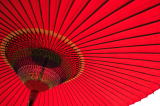 D.D.Revolution
D.D.Revolution